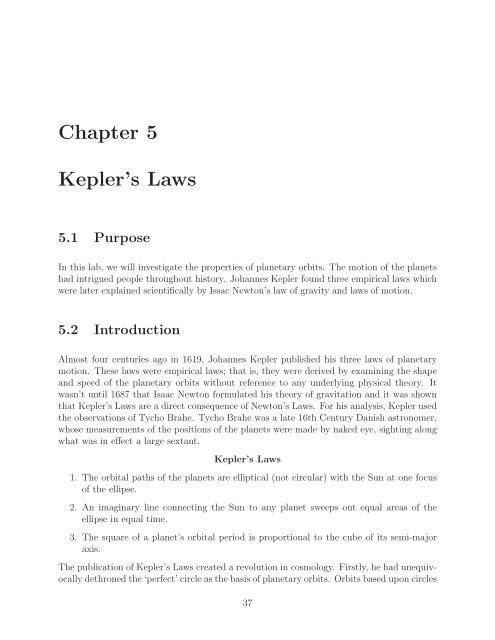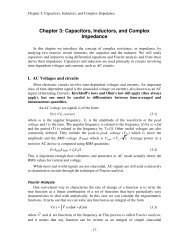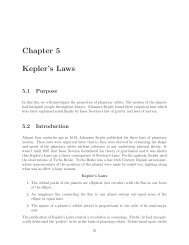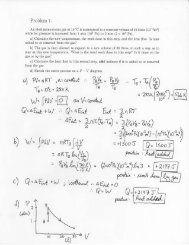Chapter 5 Kepler's Laws - Physics
Chapter 5 Kepler's Laws - Physics
Chapter 5 Kepler's Laws - Physics
Create successful ePaper yourself
Turn your PDF publications into a flip-book with our unique Google optimized e-Paper software.
<strong>Chapter</strong> 5<br />
Kepler’s <strong>Laws</strong><br />
5.1 Purpose<br />
In this lab, we will investigate the properties of planetary orbits. The motion of the planets<br />
had intrigued people throughout history. Johannes Kepler found three empirical laws which<br />
were later explained scientifically by Issac Newton’s law of gravity and laws of motion.<br />
5.2 Introduction<br />
Almost four centuries ago in 1619, Johannes Kepler published his three laws of planetary<br />
motion. These laws were empirical laws; that is, they were derived by examining the shape<br />
and speed of the planetary orbits without reference to any underlying physical theory. It<br />
wasn’t until 1687 that Isaac Newton formulated his theory of gravitation and it was shown<br />
that Kepler’s <strong>Laws</strong> are a direct consequence of Newton’s <strong>Laws</strong>. For his analysis, Kepler used<br />
the observations of Tycho Brahe. Tycho Brahe was a late 16th Century Danish astronomer,<br />
whose measurements of the positions of the planets were made by naked eye, sighting along<br />
what was in effect a large sextant.<br />
Kepler’s <strong>Laws</strong><br />
1. The orbital paths of the planets are elliptical (not circular) with the Sun at one focus<br />
of the ellipse.<br />
2. An imaginary line connecting the Sun to any planet sweeps out equal areas of the<br />
ellipse in equal time.<br />
3. The square of a planet’s orbital period is proportional to the cube of its semi-major<br />
axis.<br />
The publication of Kepler’s <strong>Laws</strong> created a revolution in cosmology. Firstly, he had unequivocally<br />
dethroned the ‘perfect’ circle as the basis of planetary orbits. Orbits based upon circles<br />
37
and epicycles had existed in one form or another since the ancient Greeks. And secondly,<br />
his second and third laws expressed a direct connection between the motion of a planet and<br />
its orbital position, giving birth to the science of orbital dynamics.<br />
5.2.1 Kepler’s Constant<br />
Kepler’s First Law states that the planets’ orbits are described by ellipses with the Sun at<br />
one focus (please refer to figure 5.1, below). An ellipse appears as a somewhat flattened<br />
circle. If we place the Sun at the focus on the left, then the point in the orbit to the left,<br />
which is the planet’s closest approach to the Sun, is called the perihelion. The farthest point<br />
in the orbit is called the aphelion.<br />
Figure 5.1: Geometry of an Ellipse<br />
The semi-major axis is labeled a, and is the distance from the perihelion (or aphelion) to<br />
the center of the ellipse. The distance from the Sun’s focus to the perihelion is equal to<br />
a · (1 − e), where e is the eccentricity of the ellipse, which is a measure of how ‘flattened’<br />
different ellipses are. The distance from the Sun’s focus to the aphelion is equal to a ·(1+e).<br />
The sum of these two distances is equal to 2a, and is called the major axis.<br />
Kepler’s Third Law states that the square of a planet’s orbital period, which we will call P,<br />
is proportional to the cube of its semi-major axis, a. We can write this in equation form<br />
as:<br />
P 2<br />
= constant (5.1)<br />
a3 Many people get confused about the nature of this constant, which we’ll call κ. κ isn’t a<br />
universal constant, like the speed of light or Newton’s G. Rather, κ depends on the particular<br />
body that’s being orbited (e.g., the Sun). Indeed, we’ll discover that the Sun has a unique<br />
κ (which we could call κ⊙) that’s different from Jupiter’s κ . It’s like saying that you’d<br />
have a different weight on the Moon than you do on the Earth (in fact, κ is related to your<br />
weight!).<br />
38
Isaac Newton later showed that the constant term is proportional to the inverse of the mass<br />
of the sun ( 1/MassSolar Units).<br />
Often, non-standard units (Earth units) are used to calculate the value of this constant. In<br />
this system, the orbital period of a planet is measured in years. The distance from the Sun<br />
is measured in astronomical units (A.U.). In these units, the value of the constant is 1 yr2<br />
AU3 since the Earth is one AU from the Sun, the the Earth’s orbit is nearly circular and the<br />
period is one year.<br />
Kepler’s grand achievement was in showing that the planetary orbits were best described<br />
by ellipses. A circle, however, is also a kind of ellipse with the two foci at the center, an<br />
eccentricity of zero, and a semi-major axis equal to the radius of the circle. All of Kepler’s<br />
laws also hold for a perfectly circular orbit, since it is just a special kind of ellipse.<br />
5.3 Procedure<br />
First open the ’Planetary Orbit Simulator’ software in a web browser. The software is on<br />
the astronomy lab web page. Go to software and then select ’Kepler’. When you open the<br />
software, you should see a window that looks like figure 5.2<br />
Figure 5.2: Planetary Orbit Simulator software from naap<br />
5.3.1 Orbits around the Sun - Mercury and Mars<br />
First we will examine the orbits of Mercury and Mars. These planets were chosen because<br />
their orbits are the most elliptical of the inner planets. The eccentricity of Mars’ orbit is<br />
0.093. Mercury’s eccentricity is 0.206. By comparison, Venus’s nearly-circular orbit has an<br />
eccentricity of 0.007.<br />
39
1. Select the ’First Law’ tab if it is not selected. Select ’Mercury’ from the upper right<br />
pull down menu and click ’ok’. Check all five options (show center, show empty focus,<br />
show semimajor axis, show semiminor axis and show radial lines.) in the First law tab.<br />
Check the ’show grid’ option in the lower right.<br />
2. Place the pointer on the gray circle that represents the planet and hold the left mouse<br />
button down. You can drag the planet around to different positions around its orbit.<br />
Place the planet at its perihelion all the way to the left of the orbit.<br />
3. In the First law tab, the values for r1 (the distance to the Sun) and r2 (the distance to<br />
the empty focus) are shown. Recored the value for r1 for Mercury’s perihelion below.<br />
Move the planet to the<br />
Mercury’s perihelion Mercury’s aphelion<br />
4. Using the relation perihelion = a · (1 − e) = a − ae and aphelion = a · (1 + e) = a + ae,<br />
calculate the semimajor axis ’a’. (hint: add the two equations and the ’ae’ term will<br />
drop out). Show your calculation below.<br />
5. Plug the value for the semimajor axis back into either relationship and find the eccentricity.<br />
Does your calculated values from the aphelion and perihelion agree with the<br />
values given in the upper left of the ’Planetary Orbit Simulator’<br />
6. Using the period of Mercury (P ) of 0.24 Earth years, calculate Kepler’s constant<br />
below:<br />
7. Select Mars from the pull down menu at the upper right and click ’ok’. Repeat the<br />
above procedure for Mars. The period of Mars (P ♂ ) is 1.88 Earth years.<br />
Mars’ perihelion Mars’ aphelion<br />
Mars’ Semimajor axis Mars’ eccentricity<br />
Kepler’s constant for Mars<br />
40
5.3.2 The Moons of Jupiter<br />
A short time after hearing of its invention in Holland in the early 1600s, Galileo Galilei<br />
constructed a telescope and discovered the four largest satellites of the planet Jupiter. In<br />
this part of the exercise we will examine their orbital motions. Since the orbits of these<br />
moons of Jupiter have very small eccentricities, the average distance from Jupiter can be<br />
used as the semimajor axis.<br />
1. A table of values (Table 5.1)for Galilei’s moons of Jupiter is shown below. The data is<br />
given in kilometers and earth days so the units for Kepler’s constant will be day 2 /km 3 .<br />
2. Fill in the table using Kepler’s 3rd law.<br />
Moon ave distance (km) Period (days) Kepler’s Constant (κ)<br />
Io 4.21 x 10 5 1.769<br />
Europa 6.71 x 10 5 3.551<br />
Ganymede 1.07 x 10 6 7.155<br />
Callisto 1.88 x 10 6 4.172 x 10 −17 day 2 /km 3<br />
5.3.3 Kepler’s second law<br />
Table 5.1: Data for the Moons of Jupiter,<br />
In this section, we will explore some features of Kepler’s 2 nd law.<br />
1. Click the ’clear Optional Features’ and select the ’Kepler’s 2nd law’ tab.<br />
2. Set the semimajor axis to 1 AU and the eccentricity to 0.5 by using the slider or typing<br />
the values into the appropriate boxes.<br />
3. Click the ’Start Animation’ button and check the ’start sweeping’. Click the ’pause<br />
animation’ button.<br />
4. Place the pointer over the sweep segment, click and hold the left mouse button and<br />
drag the sweep segment around the orbit.<br />
5. Where is the sweep segment the thinnest? Where is it the widest? Where is the planet<br />
when it is sweeping out each of these segments? What names do astronomers use for<br />
these positions?<br />
41
5.3.4 Questions<br />
1. Convert the value of Kepler’s constant for objects around the Sun (≈ 1 yr 2 /AU 3 ) from<br />
yr 2<br />
AU 3 to SI units of s2<br />
m 3. 1 AU = 1.496 x 10 11 meters<br />
2. We can combine Newton’s <strong>Laws</strong> with Kepler’s <strong>Laws</strong> to get:<br />
κ =<br />
2 P 4π2<br />
=<br />
a3 GM ,<br />
where G is the Universal Gravitational constant, G = 6.67 × 10 −11 m 3 /s 2 · kg, and<br />
M is the mass of the Sun (or whatever is being orbited). Using your result from<br />
Question 1, solve this equation for M. How does this compare with the accepted value<br />
of M = 1.99 × 10 30 kg? Calculate the % error.<br />
3. Halley’s comet has a large eccentricity (0.967). The period of Halley’s comet is 75.3<br />
years. What is the semimajor axis (a) for Halley’s comets highly elliptical orbit?<br />
4. Also from Sir Isaac’s <strong>Laws</strong>, we can derive the speed of an object in orbit around the<br />
Sun at any place using <br />
2 1<br />
v = GM − ,<br />
r a<br />
where r is the distance from the Sun and a is the semi-major axis.<br />
42
(a) Convert your value of a for Halley’s Comet from AU to m. The aphelion for<br />
Halley’s comet is 35.1 AU and the perihelion is 0.586 AU. Convert the aphelion<br />
and the perihelion into m.<br />
(b) Calculate the speed of Halley’s comet at its perihelion and aphelion.<br />
5.4 Conclusion<br />
Write a conclusion about what you have learned. Include all relevant numbers you have<br />
measure with errors. Sources of error should also be included.<br />
43











